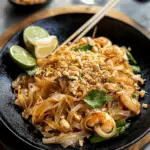This Momofuku Bossam is a flavorful feast, featuring tender, slow-cooked pork belly complemented by spicy kimchi and a rich gochujang sauce. The result is an irresistible combination of savory, sweet, and spicy flavors. The slow cooking process ensures that the pork is melt-in-your-mouth tender, while the kimchi adds a refreshing, tangy crunch.
Perfect for any occasion, this dish offers an authentic Korean dining experience that will transport you straight to the heart of Seoul. Whether you’re making it for a special dinner or simply looking to spice up your weekly meals, this Korean delicacy will surely become a favorite in your home. Serve with steamed rice or on its own with kimchi for an unforgettable meal.
Full Recipe:
-
2 lbs (900g) pork belly, skin-on
-
3 tbsp sugar
-
3 tbsp sea salt
-
4 cups water
-
2 cups apple cider vinegar
-
1 onion, quartered
-
2 cloves garlic, smashed
-
1-inch piece of ginger, sliced
-
3 tbsp soy sauce
-
1 tbsp rice vinegar
-
1 tbsp sesame oil
-
1 tbsp sugar
-
2 tbsp gochujang (Korean chili paste)
-
2 tbsp toasted sesame seeds
-
2 tbsp green onions, chopped
-
1 cup napa cabbage kimchi (for serving)
Directions:
-
Place the pork belly in a large pot. In a separate bowl, mix the sugar and sea salt, then rub this mixture generously over the pork belly.
-
Add the water, apple cider vinegar, onion, garlic, and ginger to the pot. Bring to a boil, then reduce the heat to low and simmer for 2.5 to 3 hours until the pork is tender and fully cooked.
-
Once cooked, remove the pork belly from the liquid and let it rest for 10 minutes.
-
For the sauce: In a small saucepan, combine soy sauce, rice vinegar, sesame oil, sugar, gochujang, and sesame seeds. Heat over medium heat, stirring until well combined.
-
Slice the pork belly into bite-sized pieces. Serve with a drizzle of the gochujang sauce, chopped green onions, and kimchi on the side.
Prep Time: 15 minutes | Cooking Time: 3 hours | Total Time: 3 hours 15 minutes
Kcal: 450 kcal | Servings: 4 servings
Momofuku Bossam: Korean Slow-Cooked Pork
Introduction to Momofuku Bossam
Momofuku Bossam is a renowned Korean dish that gained fame worldwide thanks to David Chang, the celebrated chef behind the Momofuku restaurant empire. It’s a slow-cooked pork recipe that combines flavors from traditional Korean cuisine with a unique, elevated twist. Bossam is a delightful and interactive dish where tender, slow-cooked pork belly is served alongside fresh condiments, lettuce wraps, and spicy sauces. The slow-roasted pork, infused with salt and sugar, becomes melt-in-your-mouth tender and is crowned with a luscious brown sugar crust. The dish is a celebration of flavors—savory, spicy, and tangy—and it’s meant to be eaten in a fun, hands-on way, often with friends and family gathered around the table.
The Tradition of Bossam
Bossam, which literally translates to “wrapped” in Korean, is a dish that has deep cultural significance in Korea. Traditionally, it is enjoyed as a celebratory meal or during holidays, and it’s particularly popular for gatherings. What makes Momofuku’s version of Bossam stand out is the luxurious quality of the pork, combined with a modern take on the accompaniments. David Chang’s adaptation focuses on a more flavorful, concentrated pork profile that is slow-cooked to perfection, ensuring the meat is tender and juicy, and topped with a sweet, crispy sugar crust. The addition of ginger shallot sauce and spicy ssam sauce offers a beautiful contrast of flavors, making each bite a burst of deliciousness.
The Pork: Choosing the Right Cut
For the perfect Bossam, the cut of pork is essential. The ideal choice is pork butt or shoulder, a larger, juicy cut that holds up well to slow roasting. The pork should be skinless, and having it bone-in ensures the meat cooks evenly. Pork butt is an excellent cut because it’s marbled with fat, which keeps it juicy during the lengthy cooking process. The goal is to achieve perfectly tender pork that can be shredded with just two forks, making it easy to serve.
The Slow-Cooking Process: The Key to Tenderness
The beauty of this recipe lies in the slow-cooking process. The pork is first dry-cured with a mix of salt and sugar, which seasons the meat from the inside out and helps it retain moisture. The curing process can last anywhere from six hours to as long as 36 hours, allowing the flavors to penetrate deeply into the pork. This step is crucial for achieving that mouth-watering tenderness and flavor profile.
Once the pork has been properly cured, it’s slow-roasted at a low temperature for several hours. The long, slow roast ensures that the fat renders out, and the meat becomes fall-apart tender. Every part of the pork is infused with the seasoning mixture, and the slow cooking process guarantees that no part of the meat is dry.
The Brown Sugar Crust: Sweet and Savory Perfection
After the pork has been slow-cooked to perfection, the next step is to create the iconic brown sugar crust. A combination of brown sugar and salt is sprinkled over the top of the pork, then caramelized in a very hot oven. The sugar creates a golden, crispy crust that adds a delightful contrast to the tender meat underneath. The result is a sweet-savory crust that adds another layer of flavor to the pork, making it even more irresistible.
The Accompaniments: Bringing Balance to the Dish
While the pork is undeniably the star of this dish, the accompaniments play a crucial role in creating the full Bossam experience. Traditionally, Bossam is served with a variety of condiments that balance the richness of the pork with refreshing flavors and textures. At Momofuku, David Chang serves the pork alongside lettuce leaves, cooked white rice, kimchi, and raw oysters.
The lettuce leaves are used as a wrap for the pork and condiments, creating a refreshing and crunchy contrast to the rich pork. The kimchi, with its spicy and tangy flavors, provides a perfect counterpoint to the sweetness of the pork. If you’re feeling adventurous, raw oysters are traditionally served with Bossam, adding a surprising texture and a touch of briny flavor that complements the richness of the pork.
Ginger Shallot Sauce: A Tangy Kick
One of the standout elements of this dish is the ginger shallot sauce, which adds a tangy and aromatic component to each bite. The sauce is made from thinly sliced scallions, fresh ginger, and a mix of oil, soy sauce, and sherry vinegar. When the ingredients are mixed together, they create a fresh, zingy sauce that enhances the flavor of the pork without overpowering it. Letting the sauce stand for 20 minutes allows the flavors to meld, giving it a deeper, more robust profile.
Ssam Sauce: Spicy and Bold
To add some heat to the Bossam, a spicy ssam sauce is made from ssamjang (a Korean chili paste) and gochujang (another type of Korean chili paste). The sauce also contains sherry vinegar, which balances the heat with a touch of acidity. This spicy sauce adds a vibrant kick to the pork and allows those who enjoy spice to elevate the dish to their liking.
Serving Momofuku Bossam: A Feast for the Senses
Once the pork is roasted and the crust is formed, it’s time to serve the Bossam. The pork is placed on a large platter, accompanied by the lettuce leaves, kimchi, rice, oysters, and sauces. The beauty of this dish is that it’s designed for DIY enjoyment—everyone gets to create their own wraps, building layers of flavor with rice, tender pork, kimchi, sauce, and the optional oysters.
The experience of eating Bossam is as much about the flavors as it is about the interaction. The pork can be shredded to the desired amount, and each person builds their own lettuce wrap, ensuring that everyone gets a personalized bite. The tender pork, the tangy kimchi, and the sweet-spicy sauces all come together in a mouthful that’s rich in flavor and texture.
The Epic Eating Experience
Momofuku Bossam is a dish that’s meant to be shared, and it’s perfect for a gathering with friends or family. The fun of assembling your own wraps and enjoying the layers of flavors together creates a sense of community and connection around the table. Whether you’re celebrating a special occasion or simply looking to treat yourself to something extraordinary, Bossam offers an unforgettable dining experience that will leave everyone talking for years to come.
Conclusion: A Must-Try Korean Dish
In conclusion, Momofuku Bossam is a magnificent dish that showcases the depth of Korean cuisine with a modern twist. The combination of slow-cooked pork belly, the crunchy lettuce wraps, the spicy sauces, and the tangy kimchi creates a harmonious and memorable meal. David Chang’s take on Bossam offers a level of refinement and flavor complexity that’s perfect for anyone looking to explore new culinary horizons. If you’re craving a dish that’s rich in flavor, culture, and culinary tradition, Momofuku Bossam is an absolute must-try.






